White Papers
PRN & App-Based Nurse Staffing: Transforming Healthcare
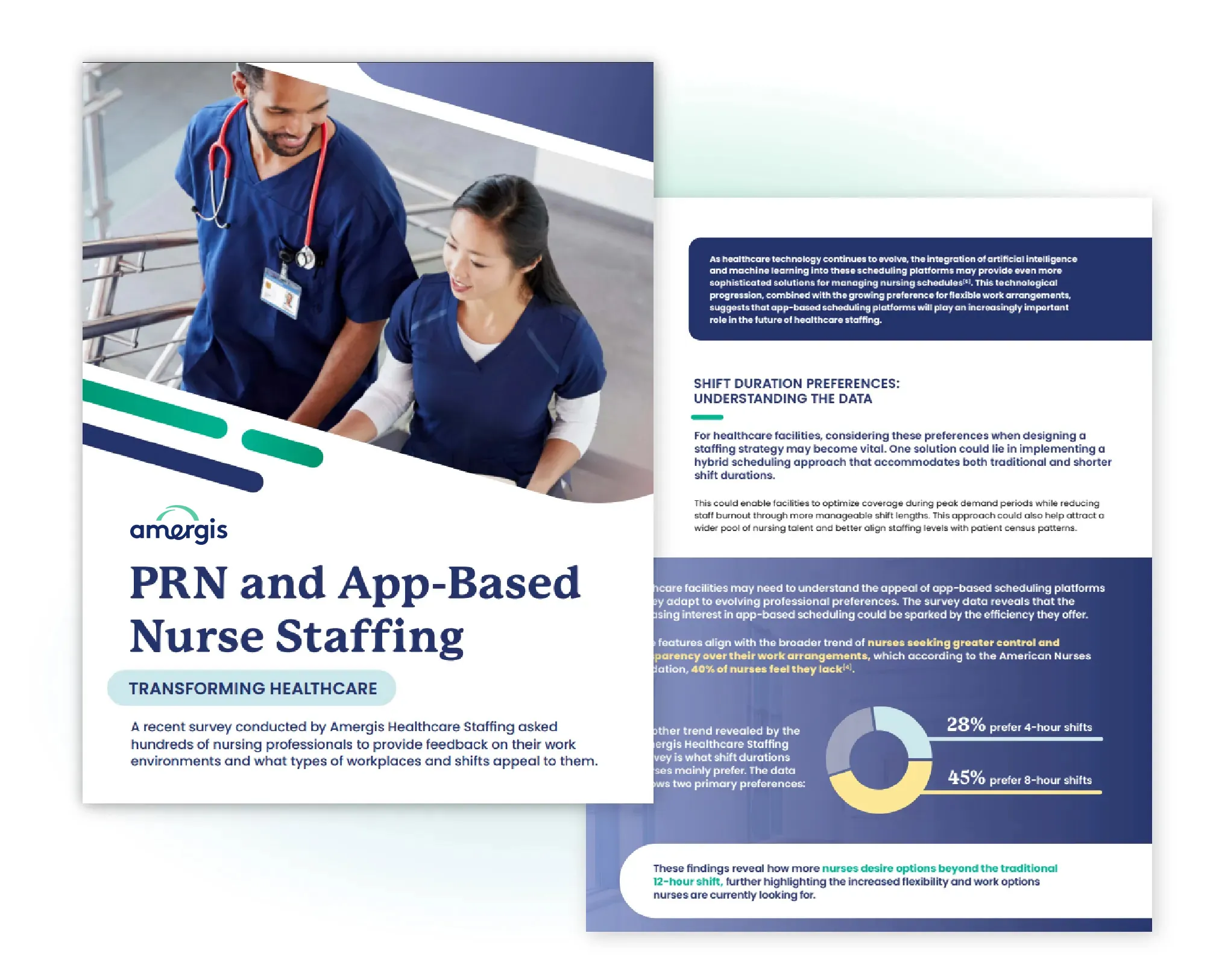

A recent survey conducted by our team at Amergis Healthcare Staffing asked hundreds of nursing professionals to provide feedback on their work environments and what types of workplaces and shifts appeal to them. One of the most striking discoveries from the survey was the rise in preferences for PRN (pro re nata, meaning “as the need arises”) and app-based shift options. This transformation has the potential to reshape the way healthcare facilities manage their staffing needs and how nurses approach their careers.
The survey reveals a striking desire for PRN work among nursing professionals, with a substantial 69% of nurses surveyed expressing a preference for PRN work, which typically involves working single shifts rather than committing to full-time positions. The healthcare industry is witnessing a significant shift in nursing employment models, with a notable rise in PRN (pro re nata, meaning “as the need arises”) and app-based options.
This transformation is reshaping the way healthcare facilities manage their staffing needs and how nurses approach their careers. In this white paper, we explore recent survey data showing a shift among nursing professionals towards PRN and app-based job options, the reasons for the changing preferences, and the potential impact on healthcare staffing and patient care.
THE GROWING DEMAND FOR PRN WORK

While PRN and per diem are often used interchangeably as temporary work arrangements, there are important distinctions between the two.
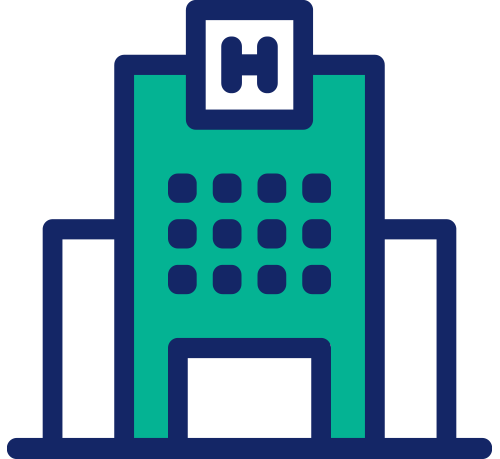
The main difference is that PRN nurses are bound to work in one facility, while per diem nurses can work for multiple facilities at once.
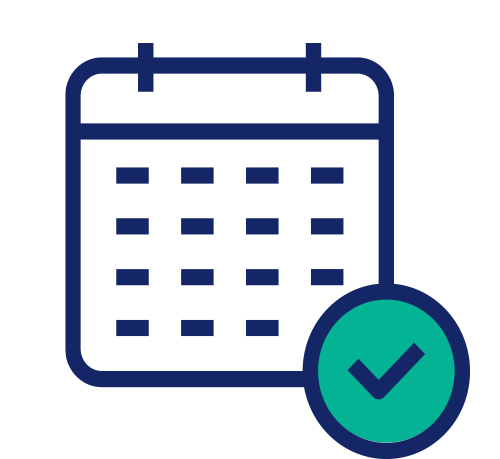
As a result, PRN nurses often have to follow a facility’s workplace policy on the minimum number of hours worked per week, while per diem nurses have more flexibility to choose their work hours.
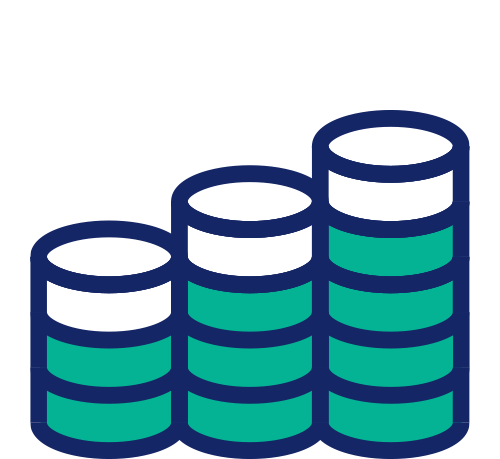
This requirement, however, can be beneficial for PRN nurses, as it means they are guaranteed a specific number of shifts and receive workplace benefits[1].
This simultaneous flexibility and security offered by PRN work might be a potential factor in why there is increasing interest among nurses, with an overwhelming percentage of nurses looking for greater freedom in their work options.


This highlights the rising preference for nurses to have more control over their work schedules. Working PRN shifts allows nurses to choose schedules that best fit their lifestyles, helping them balance work with personal commitments more effectively. This can be particularly important in a profession known for its high-stress levels and potential for burnout[2].
PRN work also offers professionals a better sense of job security thanks to the requirements these jobs have on the number of hours worked per week. This can be particularly appealing to nurses who want freedom over their scheduling but are concerned about the lack of guarantees involved in finding per diem shifts. Furthermore, PRN jobs offer nurses the opportunity to work in different departments within a healthcare facility, which could help broaden their skill set and enhance their resume[3]. This ability to gain new and varied experiences is another factor that could influence nurses to look for PRN opportunities.
As healthcare facilities adapt to accommodate this increasing preference for PRN work, many of them will also have to embrace app-based scheduling platforms that streamline opportunity discovery for professionals. The rise of these platforms represents a natural progression in the evolution of healthcare staffing, offering both facilities and professionals an optimized approach to shift management.
APP-BASED SHIFT OPTIONS:
THE FUTURE OF NURSING SCHEDULES

The healthcare industry’s increasing adoption of digital solutions has extended to scheduling practices, with app-based platforms emerging as a promising tool for managing nursing shifts. According to the Amergis Healthcare Staffing survey, there is substantial interest in these digital scheduling solutions among nursing professionals.
Beyond the appeals for professionals, app-based staffing platforms also present some possible advantages for healthcare facilities. The digital nature of app-based scheduling allows for more efficient shift management, giving facilities the ability to better fill vacancies and respond to sudden staffing needs. Furthermore, these platforms often include features that help maintain consistent quality of care, such as credential tracking and performance monitoring capabilities[5]. This technological infrastructure can be particularly valuable for facilities managing a mix of full-time, PRN, and per diem staff

63% say they value the ability to view all available shifts in one place

58% appreciate the instant confirmation of their schedule selections

47% cited the ease of communication through these platforms as a significant benefit

As healthcare technology continues to evolve, the integration of artificial intelligence and machine learning into these scheduling platforms may provide even more sophisticated solutions for managing nursing schedules[6]. This technological progression, combined with the growing preference for flexible work arrangements, suggests that app-based scheduling platforms will play an increasingly important role in the future of healthcare staffing.
SHIFT DURATION PREFERENCES:
UNDERSTANDING THE DATA

For healthcare facilities, considering these preferences when designing a staffing strategy may become vital. One solution could lie in implementing a hybrid scheduling approach that accommodates both traditional and shorter shift durations.
This could enable facilities to optimize coverage during peak demand periods while reducing staff burnout through more manageable shift lengths. This approach could also help attract a wider pool of nursing talent and better align staffing levels with patient census patterns.
Healthcare facilities may need to understand the appeal of app-based scheduling platforms as they adapt to evolving professional preferences. The survey data reveals that the increasing interest in app-based scheduling could be sparked by the efficiency they offer.
These features align with the broader trend of nurses seeking greater control and transparency over their work arrangements, which according to the American Nurses Foundation, 40% of nurses feel they lack[4].
Another trend revealed by the Amergis Healthcare Staffing survey is what shift durations nurses mainly prefer. The data shows two primary preferences:
These findings reveal how more nurses desire options beyond the traditional 12-hour shift, further highlighting the increased flexibility and work options nurses are currently looking for.
THE IMPLICATIONS FOR
HEALTHCARE STAFFING

The implications of the growing demand for PRN work and flexibility are far-reaching and may require healthcare facilities to fundamentally reimagine their staffing approaches. To effectively adapt to the shifting workforce preference, healthcare organizations will need to implement both structural and cultural changes in their operations.

First and foremost, facilities may need to develop more sophisticated scheduling systems that can efficiently manage a mix of PRN, per diem, and full-time staff while ensuring consistent coverage. This includes creating sophisticated digital platforms to streamline shift selection and management, as well as implementing smart scheduling algorithms to balance staff preferences with facility needs.

Healthcare organizations may also need to expand their partnerships with staffing agencies to build reliable pools of qualified PRN nurses and assist in offering app-based scheduling options. These partnerships should focus on streamlining the onboarding process, ensuring compliance with facility-specific requirements, and maintaining consistent quality of care standards across all staffing types.

Furthermore, organizations may benefit from Vendor Management Systems (VMS) when managing their expanding contingent workforce. A VMS provides a centralized platform for managing multiple staffing vendors, streamlining job postings, candidate submissions, time tracking, and billing. This technology might be particularly valuable for managing large pools of PRN and per diem staff across multiple departments or facilities.
By implementing a VMS, healthcare organizations could reduce administrative overhead, improve compliance, and gather staffing metrics. The data analytics capabilities of modern VMS platforms may enable facilities to analyze staffing patterns, costs, and performance metrics, supporting more informed workforce planning decisions.

Equally important is the restructuring of compensation and benefits packages to better align with PRN work preferences. This may involve offering competitive benefits, providing scaled benefits based on hours worked for PRN nurses, and creating incentive programs for consistent availability during high-need periods.
According to the Amergis Healthcare Staffing survey, 67% of nurses said the primary reason for them to work with a staffing agency is compensation and benefits, emphasizing the importance of comprehensive benefits packages. This also highlights the significance of staffing agencies in the future of healthcare, since they often take the burden of providing benefits off of facilities.
Amidst the shifts happening in the healthcare industry, facilities that successfully adapt to these changing workforce preferences should be better positioned to maintain adequate staffing levels, ensure quality patient care, and create sustainable staffing solutions for the future. Understanding and embracing this shift toward PRN work may prove crucial for healthcare organizations seeking to build resilient and adaptable workforce strategies in an increasingly dynamic healthcare environment.
EMBRACING THE EVOLUTION
OF HEALTHCARE STAFFING

The healthcare staffing landscape is undergoing a fundamental transformation, driven by several key factors identified in our research:
- Strong preference for PRN work (69% of surveyed nurses)
- Growing adoption of app-based scheduling (51% interest)
- Emphasis on work-life balance and flexibility
- Integration of technology in workforce management
Healthcare organizations may need to adapt to flexible scheduling preferences while leveraging technology and staffing agencies effectively. These institutions will need to maintain high standards of patient care while creating supportive work environments and offering competitive benefits. Those organizations that embrace these changes while maintaining focus on quality care might be best positioned for success in the future healthcare landscape.
References
Amergis Healthcare Staffing. (2024). Nursing Insights Survey. Amergis Healthcare Staffing. https://www.amergis.com/
resources/key-nursing-insights-2024-survey/
American Nurses Association. (2024a). What is per diem nursing and how does it work?. American Nurses Association.
https://www.nursingworld.org/content-hub/resources/nursing-resources/per-diem-nursing/
American Nurses Association. (2024b). Nurse burnout: What is it & how to prevent it. American Nurses Association. https://
www.nursingworld.org/content-hub/resources/workplace/what-is-nurse-burnout-how-to-prevent-it/
Berlin, G., Herbig, B., Judge, K., Murphy, M., Burns, F., & Hanley, A. (2023, November). Understanding and prioritizing nurses’
mental health and well-being. American Nurses Foundation. https://www.nursingworld.org/~4aaf68/contentassets/
ce8e88bd395b4aa38a3ccb583733d6a3/understanding-and-prioritizing-nurses-mental-health-and-well-being.pdf
Gupta, N. (2024, September 24). Transforming healthcare with effective scheduling. McKnight’s Long-Term Care News.
https://www.mcknights.com/marketplace/marketplace-experts/transforming-healthcare-with-effective-scheduling/
Mills, T. (2019, September 4). How health care apps can improve patient health and support physicians. Forbes. https://www.
forbes.com/councils/forbestechcouncil/2019/09/04/how-health-care-apps-can-improve-patient-health-and-supportphysicians/
Saint Paul’s School of Nursing. (2021). What is a PRN and why should I consider it?. Saint Paul’s School of Nursing. https://www.
stpaulsschoolofnursing.edu/blog/nursing/what-is-a-prn-and-why-should-i-consider-it-.html
Do you need help quickly finding qualified healthcare professionals for your facility ?
Get the latest blogs, news and company updates
Want to get the latest staffing related news and updates? Subscribe to our resources to get insights sent straight to your inbox.